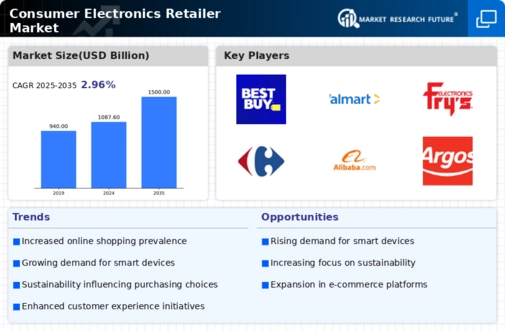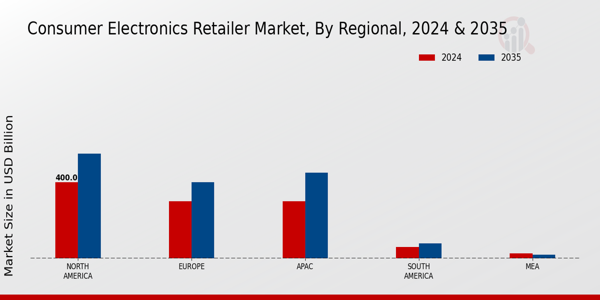E-commerce Growth
The rise of e-commerce significantly influences the Global Consumer Electronics Retailer Market Industry. With more consumers opting for online shopping, retailers are expanding their digital presence to capture this growing segment. The convenience of online purchasing, coupled with competitive pricing and extensive product selections, drives consumer engagement. In 2024, the market is anticipated to reach 1087.6 USD Billion, underscoring the importance of e-commerce in retail strategies. Retailers that invest in robust online platforms and logistics are likely to thrive, as the shift towards digital shopping continues to reshape consumer behavior.
Sustainability Trends
Sustainability is becoming a crucial driver in the Global Consumer Electronics Retailer Market Industry. Consumers are increasingly aware of environmental issues and prefer products that are eco-friendly and energy-efficient. Retailers are responding by offering sustainable product lines and promoting recycling initiatives. This shift not only aligns with consumer values but also enhances brand loyalty. As the market evolves, the emphasis on sustainability is expected to grow, potentially influencing market dynamics and contributing to a projected market value of 1500 USD Billion by 2035. Retailers that prioritize sustainability may gain a competitive edge.
Global Economic Factors
Economic factors play a significant role in shaping the Global Consumer Electronics Retailer Market Industry. Fluctuations in disposable income, consumer confidence, and overall economic stability influence purchasing behavior. In regions experiencing economic growth, consumers are more likely to invest in new electronics, thereby boosting market performance. The anticipated market value of 1500 USD Billion by 2035 indicates a positive outlook, although economic uncertainties could pose challenges. Retailers must navigate these dynamics carefully, adapting their strategies to align with changing economic conditions and consumer sentiment.
Market Growth Projections
The Global Consumer Electronics Retailer Market Industry is characterized by promising growth projections. With an expected market value of 1087.6 USD Billion in 2024 and a projected CAGR of 2.97% from 2025 to 2035, the industry demonstrates resilience and adaptability. This growth trajectory suggests that retailers will continue to innovate and expand their offerings to meet evolving consumer needs. The anticipated increase to 1500 USD Billion by 2035 reflects the industry's potential, driven by technological advancements, consumer demand, and strategic investments in e-commerce and sustainability.
Technological Advancements
The Global Consumer Electronics Retailer Market Industry is propelled by rapid technological advancements. Innovations in smart devices, such as smartphones, tablets, and smart home appliances, are reshaping consumer preferences. For instance, the integration of artificial intelligence and the Internet of Things into everyday products enhances user experience and functionality. As consumers increasingly seek connected devices, retailers are adapting their offerings to meet these demands. This trend is expected to contribute to the market's growth, with projections indicating a market value of 1087.6 USD Billion in 2024, reflecting the industry's responsiveness to technological evolution.
Consumer Demand for Smart Devices
The demand for smart devices is a key factor in the Global Consumer Electronics Retailer Market Industry. As consumers seek enhanced connectivity and functionality, products such as smart TVs, wearables, and home automation systems are gaining popularity. This trend is reflected in the market's projected growth, with an expected value of 1087.6 USD Billion in 2024. Retailers are increasingly focusing on these high-demand categories to attract tech-savvy consumers. The continuous evolution of smart technology suggests that this demand will persist, driving innovation and competition within the industry.
























